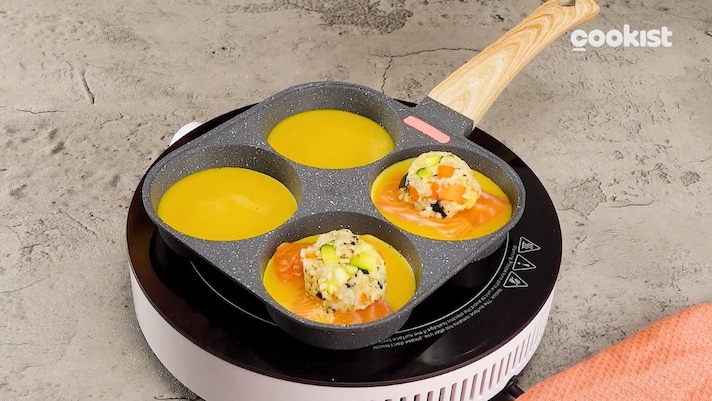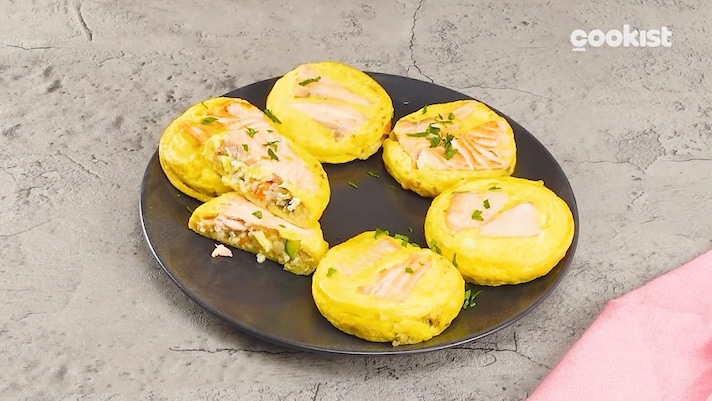
Salmon and Rice Frittata is a recipe that combines the rich flavors of salmon with the versatility of eggs and rice, creating a dish that's both nutritious and appealing. Featuring a mix of sesame seeds, soy sauce, carrot, zucchini, and seaweed sheet, this method involves layering ingredients in a muffin pan for a unique presentation. The process begins by placing salmon in the pan, topped with beaten eggs and a hearty mixture of rice and vegetables, then finished with another layer of egg. Perfect for a weekend brunch or a special family dinner, this dish can be enjoyed with friends and loved ones, offering a creative twist on traditional ingredients.
What Are Salmon Frittatas?
The frittata, an emblem of Italian cuisine, originates from the verb friggere, meaning "to fry," though it's now typically baked or started in a pan and finished under a broiler. This egg-based dish has its roots in the Italian countryside, where it was crafted from leftover ingredients like vegetables, meats, and cheeses, making it a versatile and economical meal. Traditionally cooked slowly over low heat, the frittata allowed flavors to meld deeply, differentiating it from the quickly-cooked omelette.
Salmon frittatas, while not traditional in Italian cooking, represent a modern culinary fusion that combines the rich flavors of salmon—valued for its omega-3 fatty acids—with the creamy texture of eggs. This adaptation has gained popularity worldwide, particularly in regions where salmon is readily available, marrying global tastes with nutritional benefits. Today, salmon frittatas are savored as a nutritious option for any meal, embodying the adaptability and enduring appeal of this classic Italian dish in kitchens around the globe.
Tips for the Best Salmon Frittata
– Use fresh, high-quality salmon for the best flavor and texture. Fresh vegetables like carrots and zucchini should be crisp and vibrant, adding not only taste but also a pleasing aesthetic to the dish.
– Ensure that the salmon pieces are cut uniformly to promote even cooking. Similarly, dice the carrots and zucchini into small, consistent pieces to ensure they cook thoroughly and integrate well with the rice and eggs.
– Season the beaten eggs with a pinch of salt and pepper before pouring them into the muffin pan. This will enhance the natural flavors of the salmon and vegetables.
– Grease the muffin pan well with oil or a non-stick spray to ensure that the frittata muffins can be easily removed after cooking. This is crucial for maintaining the shape and presentation of your dish.
– Cook the frittata on medium heat to prevent the eggs from burning while allowing enough time for the salmon to cook through. This gentle cooking also helps the flavors meld together better.
– Keep a close eye on the frittata as it cooks. Overcooking can dry out the eggs and make the salmon tough. Remove from heat as soon as the eggs are set and the top is slightly golden.
– Allow the frittata to cool in the pan for a few minutes before attempting to remove them. This resting period helps the frittata to set completely, making it easier to lift out of the pan without breaking.
– Serve immediately for the best taste and texture. You can garnish with a sprinkle of extra sesame seeds or a drizzle of soy sauce for an added touch of flavor and a more appealing presentation.
What Makes Frittata Spongy?
The sponginess of a frittata largely depends on how the eggs are handled during preparation. Beating the eggs well before adding them to the mix introduces air into the eggs, which helps make the frittata light and fluffy as it cooks. The heat then causes the air bubbles trapped in the beaten eggs to expand, giving the frittata a spongy texture. Additionally, cooking the frittata gently allows the eggs to set without releasing too much moisture, maintaining its softness and sponginess.
Why Did My Frittata Come Out Rubbery?
If your frittata turned out rubbery, it's likely due to a couple of key factors related to how the eggs were cooked. Eggs cook quickly and continue to cook from residual heat even after being removed from the source of heat. Overcooking can cause the proteins in the eggs to tighten excessively, squeezing out moisture and leaving a rubbery texture.
Cooking the frittata at too high a temperature can also make the eggs rubbery. High heat causes the egg proteins to coagulate too quickly, again squeezing out moisture and firming up the texture in an undesirable way.
To avoid a rubbery texture, cook the frittata on a lower heat setting and keep a close eye on it, removing it from the heat as soon as the eggs are just set but still moist.
What Can Be Served With This Frittata?
This Salmon Frittata pairs beautifully with a variety of side dishes that can complement their rich and savory flavor. A fresh green salad, dressed lightly with vinaigrette, adds a crisp, refreshing contrast to the meal. For a heartier accompaniment, roasted vegetables such as asparagus, bell peppers, or sweet potatoes offer warmth and substance. If you're aiming for a brunch setting, a side of fruit salad or a basket of warm, crusty bread can round out the meal beautifully. To enhance the flavor experience, consider a dollop of crème fraîche or a sprinkle of fresh herbs like dill or chives on top of the frittata.
Can I Use Frozen Salmon or Smoked Salmon for This Frittata?
Yes, you can use both frozen or smoked salmon in this recipe. If using frozen salmon, ensure it is fully thawed and patted dry to remove excess moisture before cooking. Smoked salmon can be used directly and will add a richer, more savory flavor to the frittata. Both options are excellent for adding variety to the dish.
More Salmon Recipes You Will Love
One Sheet Salmon and Baked Potatoes
How to Store Salmon Frittata
This Salmon Frittata should be placed in an airtight container and can be refrigerated for up to three days. It's important to ensure it's sealed well to prevent it from absorbing other flavors from the fridge. Freezing is also an option for longer storage. Wrap individual portions tightly in plastic wrap or aluminum foil, and then place them in freezer bags. When stored in the freezer, the frittata can last for up to two months. To enjoy, simply thaw in the refrigerator overnight and reheat gently to preserve the best texture and flavor.
Ingredients
How to Prepare Salmon Frittata

Inside of a muffin pan, place two pieces of salmon in two muffin spaces.
Inside of a muffin pan, place two pieces of salmon in two muffin spaces.

Pour a bit of beaten eggs on top of the pieces of salmon and let cook.
Pour a bit of beaten eggs on top of the pieces of salmon and let cook.

Meanwhile, inside of a glass bowl mix the cooked rice with the diced carrots, zucchini, sesame seeds, diced seaweed sheet and a drizzle of soy sauce. Form tiny balls with your hands.
Meanwhile, inside of a glass bowl mix the cooked rice with the diced carrots, zucchini, sesame seeds, diced seaweed sheet and a drizzle of soy sauce. Form tiny balls with your hands.

Place one ball of rice atop each of the salmon and egg frittata in the muffin pan.
Place one ball of rice atop each of the salmon and egg frittata in the muffin pan.

While they cook, pour more beaten eggs into the other two spaces of the muffin pan and let them cook for a while, covering with the pan's lid.
While they cook, pour more beaten eggs into the other two spaces of the muffin pan and let them cook for a while, covering with the pan's lid.

Once the bottom of the eggs has cooked, use a spatula to flip the two frittatas with the rice ball on top and place them on the other two egg frittatas. Keep cooking with the lid on top, all the way through.
Once the bottom of the eggs has cooked, use a spatula to flip the two frittatas with the rice ball on top and place them on the other two egg frittatas. Keep cooking with the lid on top, all the way through.

Let them cool and then remove from the pan, serve on a plate and sprinkle with fresh parsley. Eat and enjoy!
Let them cool and then remove from the pan, serve on a plate and sprinkle with fresh parsley. Eat and enjoy!

;Resize,width=767;)
